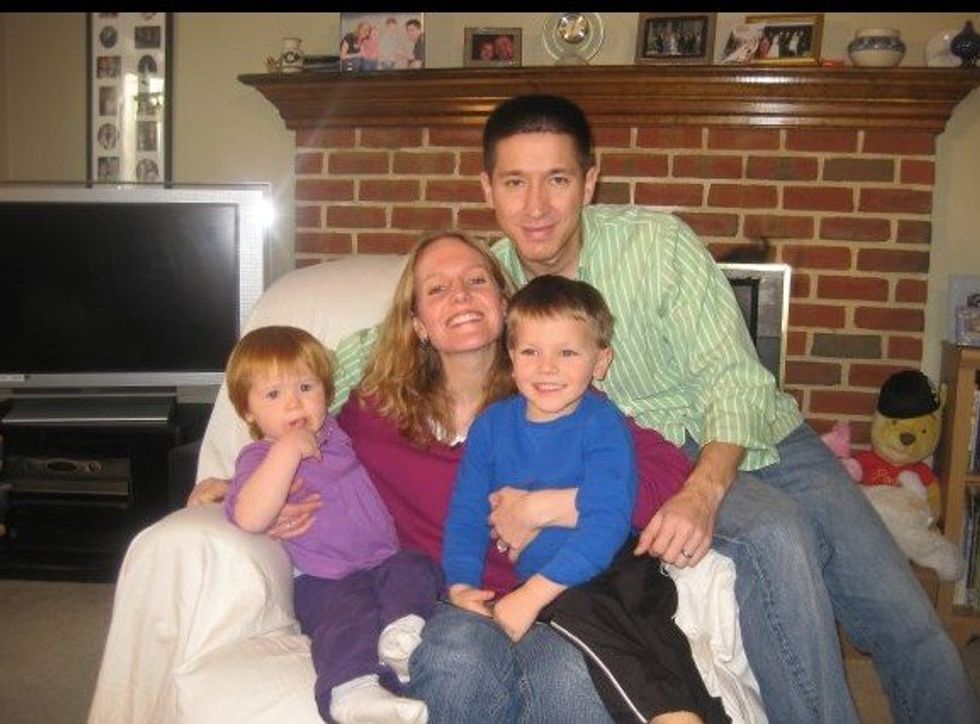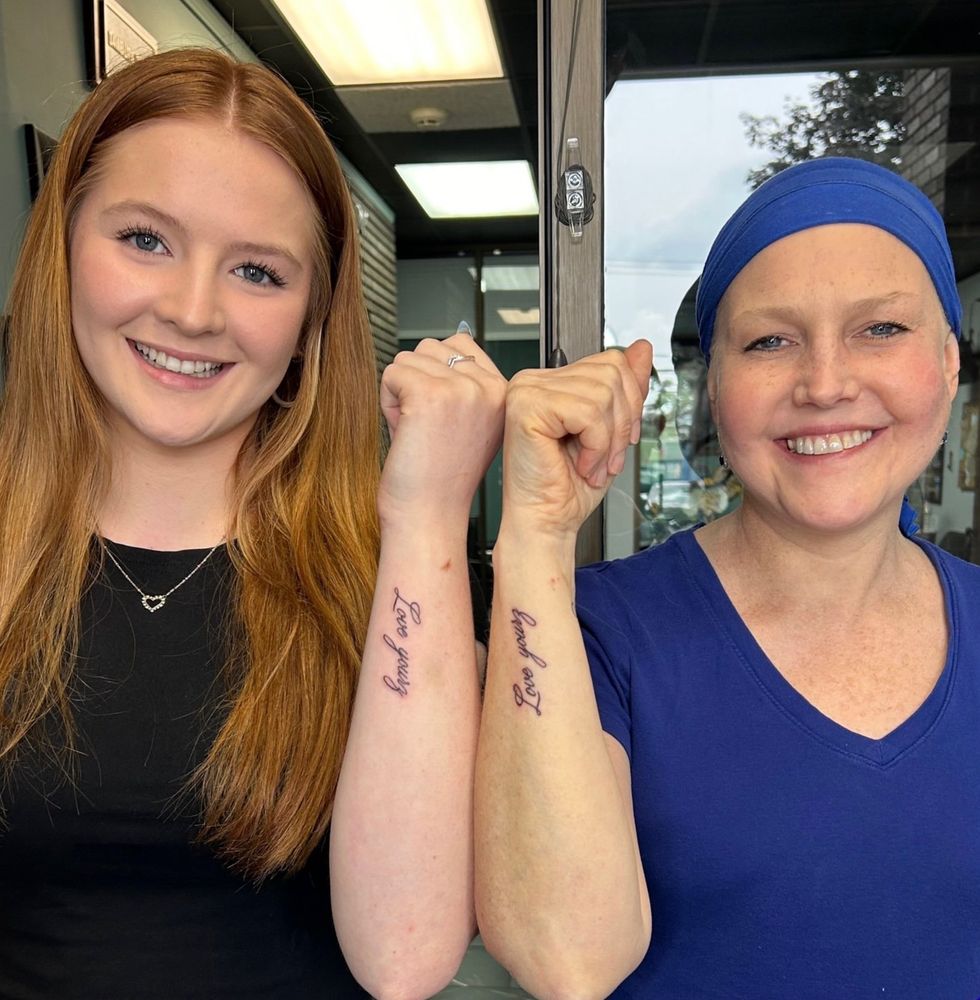As told to Erica Rimlinger
My kids were 2 and 3 years old when I found a lump in my breast. I made an appointment for a mammogram and went to the appointment alone. I’ll never forget the radiologist’s face as she reviewed the results. When she told me I had to follow up with an oncologist, I said I’d call one. She said no, we’ve made an appointment for you tomorrow. I realized I shouldn’t have come to this appointment alone.
I had breast cancer, which eventually led to a double mastectomy, reconstruction and chemotherapy. My kids were so young it was easy to direct my energy into keeping their lives as normal as possible during my treatment. It kept my spirits up, and theirs. I let them help shave my head at a shaving party to demystify mom’s new look. My husband and I read them books that explained cancer in a way that was appropriate for their ages. We told them mommy had a boo-boo.
 Emma and her family, 2008
Emma and her family, 2008
Nearly 10 years later, breast cancer seemed as long ago and far away as sippy cups and crayons. The kids were middle and high schoolers, and I had a job in New York City that I loved. Then I found another lump, and I was pulled back into that world as no time had passed at all.
My new breast surgeon in New York believed the lump was just a leftover suture — a stitch — from my surgeries years ago, and that I could ignore it. That explanation didn’t seem right to me. I’m not a pessimistic person. My gut just didn’t agree. I told my doctor I’d be more comfortable if we checked into it further, so she agreed to do an outpatient biopsy the following Monday. As I woke up from the anesthesia, she gave me a verdict: My lump was not cancer. I was relieved. I could move on with my life after all.
But four days later, my phone rang, showing my doctor’s name on the screen. I was in a meeting at work. I knew I had to answer. I knew something wasn’t right. I took the call in an empty office.
 Emma with her son, Peter, June 2024
Emma with her son, Peter, June 2024
“I’m never wrong about these things,” my doctor began. But she had been wrong this time. My lump was cancerous. Worse, it was stage 4 because the cancer was outside the chest wall. She told me I needed a PET scan. I told her I’d make the appointment. For the second time in my life, I had a doctor tell me, “We’ve already made the appointment. It’s tomorrow.”
I called my husband, Bill. I told him the news and that I didn’t know how I was going to fit in my PET scan around my upcoming business trip to Hong Kong. Bill said, with kindness, patience and maybe less shock than I was experiencing, “I don’t think you’re going anymore.” I had lost so much trust in my physician that I moved my medical care to Memorial Sloan Kettering Cancer Center.
The PET scan showed cancer in my lungs, and I immediately started treatment with a chemotherapy drug created to slow growth in the type of metastatic breast cancer I had. I stayed on that drug for nearly three years, not enjoying it much, but not realizing it would be one of my easier treatments. The chemo held my cancer at bay except for a small tumor that appeared in my bone, which was treated by ablation.
After a few years of this routine, an MRI came back showing a spot in my brain had grown. Although the doctors told me they thought the area was benign, or non-cancerous, I again had a gut feeling they were wrong. I had brain surgery right before Christmas and wasn’t surprised to wake up from surgery and learn my cancer had entered my brain. Nothing has ever been benign in my cancer journey! I started a chemotherapy treatment that crosses the blood-brain barrier.
I’d been working full-time throughout my illness and commuting to Philadelphia three days per week. My husband and I were busy raising the kids. We had a great support system in our friends and family. I was five years into my metastatic breast cancer diagnosis, but life felt far from over. I had too many goals to complete.
At a local breast cancer walk, I remember looking around and thinking, “Where’s the metastatic community?” The event was a sea of pink with no representation of the thriving community of people living with metastatic breast cancer, whose colors are green, teal and pink. We’re still here. Thanks to better treatments and advancing medical care, we’re living longer, fuller lives.
 Emma and her daughter, Lexi, 2025
Emma and her daughter, Lexi, 2025
But my body let me know I was pushing too hard to maintain my life’s busy pace when I had a seizure in my hotel room during a trip to Philadelphia. An MRI revealed another brain tumor. I took some time off work for treatment, not fully realizing I’d stop working for good. I had radiation and changed chemo treatments.
Currently, I have breast cancer in my kidney and liver, and 11 tumors in my brain. In addition, in June 2024 I was diagnosed with leptomeningeal disease, cancer in cerebrospinal fluid that results from a metastasis.
The blow hit me harder than any diagnosis I’d received until then. Leptomeningeal disease is a very rare type of cancer, with limited research and funding. Once diagnosed, a patient can expect to survive between three and six months.
Nevertheless, one year later, here I am. I’m going through my seventh round of cancer treatment, and I have options for an eighth or ninth if needed. My amazing medical team is using treatments that didn’t exist in 2008. Now that people are living longer with metastatic cancer, I’m living proof that the rate of leptomeningeal disease is going to continue to rise. This rare cancer is becoming less rare with every new advancement in cancer longevity. We just need more knowledge, awareness and funding for research.
Despite the odds, I’ve been able to see both my son’s and daughter’s high school graduations and proms. My son Peter is now a junior at Purdue University and when I dropped him off, I thought the possibility of dropping Lexi off at university would be remote. But Lexi is heading to the University of Miami and I am here to drop her off!
My next goal is to reach my 25th wedding anniversary with my husband, the unsung hero of my cancer story. He’s held us all together, encouraging me and showing unconditional love through every challenge. Even after all these years, I still light up when he enters the room. He and my whole family remind me I may have more treatments ahead of me, but I also have more life to live.
Have your own Real Women, Real Stories you want to share? Let us know.
From Your Site Articles
Related Articles Around the Web









